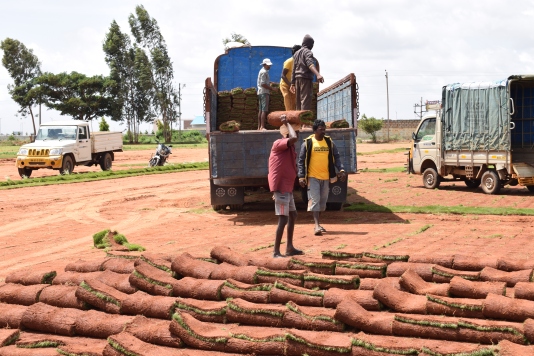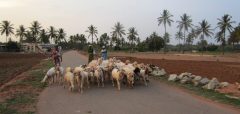(Raghvendra Vanjari, A R Shwetha, Sheetal Patil, Seema Purushothaman, Dhanya Bhaskar)
Sprawling lawns are inviting spaces. Neighbourhood parks, golf clubs and airport surroundings spread these green carpets amidst concrete jungles. While wealthy use it to play golf, urban poor use lawns in parks for an afternoon siesta. Hospitals, educational institutions, spiritual centers and real estate developers – all proudly display green lawns in their pictures. That the apparently soothing greenery often comes at the cost of fertile topsoil and water in agricultural lands and that these carpets may just be green deserts in reality, are facts conveniently overlooked.

(Image source: Creative Commons)
Lawns can be established by planting grass slips. But this takes time to establish and spread a green cover uniformly over the soil. There are different grass species requiring different levels of care and inputs to maintain uniform green cover throughout the year. Urban impatience, affluence, and indifference towards the impact of their actions on others and other landscapes ensure demand for quick but extractive green carpeting. Thus, transplanting readymade mats of grass grown elsewhere is the norm followed in most lawns we see.
Rural peripheries of North Bengaluru caters to the demand for manicured landscapes in its urban neighbourhood. Farmers in the villages of Doddaballapura and Devanahalli taluks grow Mexican lawn-grass extending to hundreds of acres. For around 10 to 15 years now, the not-so-humble lawn-grass has been holding on to the farmlands of these villages, with its shallow roots. It has displaced finger millet, pulses and even paddy from these farmlands, apart from clearing the land off bushes and trees. Village grazing lands are also often encroached for cultivating this grass. Unlike conventional crops grown or newer plantations of eucalyptus and acacia, lawn grass requires high-intensity input use.
Lawn grass, both in the farms and where they are established, generally is doused with chemicals for plant protection and enhancing vegetative growth. Rarely do we notice the absence of the usual suspects on this grassland – grasshoppers, crickets, ants and other insects. Ignorance is of course bliss. Despite the chemicals and sewage water pumped in, lush green lawns are loved spaces – children play, youngsters hold parties, elderly walk on and pets run around.
Maintaining turfgrass demands garden labour for planting, manuring, weeding, edging [1], scarifying [2], mowing and watering continually. Labour from the surrounding villages, especially women, are engaged in large numbers in turfgrass farms. Activities in these farms continue round-the-year, in cycles of 3-4 months’ duration. This, women grass workers acknowledge as a boon compared to the highly uncertain and hard jobs they were engaged in.
Cultivation of Mexican grass is undertaken by local as well as migrant farmers from neighbouring states. The average size of these farms range between five to 10 acres; though patches as small as half an acre are also used at times. The trend is to take land on lease from large holders at an annual rent of INR 60,000 an acre with bore well. Lease rate is INR 40,000 for unirrigated land, where the lessee digs bore wells and/or arranges to bring water from elsewhere. They spend large sums of money to pump out waters lying deep beneath the ground. Each farm has one or two bore wells connected to sprinklers. This grass requires water every single day without fail, except during monsoons. Farmers also have to spend on small equipments for pruning, weeding, spraying and harvesting.
Thus, turfgrass farms require an initial investment of around INR 1.5 lakhs to INR 2 lakhs an acre, including land lease charges if any, setting up irrigation facility, buying equipment etc. On the whole, the cost of cultivating a square foot[3] of lawn grass (including soil, inputs and labour) is about rupees five. Square or rectangle shaped grass sheets harvested with soil are sent to Bengaluru or to the neighbouring states of Kerala, Tamil Nadu and Andhra Pradesh, for INR 10 to 12 per square foot. Buyers from the neighbouring states visit lawn farms and do on the spot purchases in large volumes. A farmer receives nearly INR 2 -3 lakhs an acre as net income, after every harvest, once in four months.

Lawn grass harvested along with two inches of topsoil depletes the soil after about three to six harvests. As the soil begins to deplete, fresh soil, usually dug out from nearby lake beds is supplemented. The soil from lake beds is supposed to be procured from the Gram Panchayat, at around INR 500-1,000 per truckload. If silt from the lake bed is not available, turf farmer spends anywhere between INR 2,500-6,000 per truckload of soil from excavated construction sites. An acre of turf grassland requires nearly two to 2.5 truckloads of soil to be supplemented every year.

Mallappa[4] of Doddaballapur taluk started cultivating Mexican grass 15 years ago. Other farmers in the area found this lucrative and followed suit, despite knowing that their water and soil resources, along with food crops will be traded for short-term economic benefits. Health hazards to workers (mainly women) while handling chemicals and concentrated poultry manure, also cause worry. “We have already damaged our land. If we continue this, in the next 10 years these farmlands will become deserts”, he opined. For him, this is business, not agriculture. It is but another story of (rural) development – deceptively green.
[1] Edging is a process of sharpening the edges of the lawn
[2] Scarifying is the process of cutting and removing the debris (moss and dead grass) from the lawn
[3] 43,560 square feet makes an acre
[4] Name changed
(Acknowledging financial support from Department of Biotechnology, Government of India for the project ‘Ecosystem services, agricultural diversification and small farmers’ livelihoods in rural-urban interfaces of Bengaluru’ as part of Indo-German collaborative research project FOR2432)


